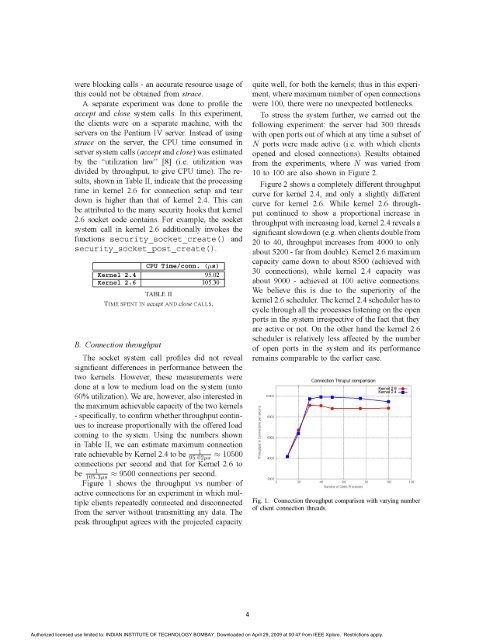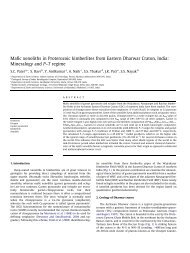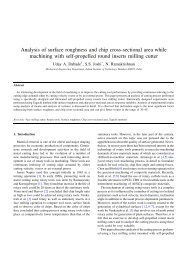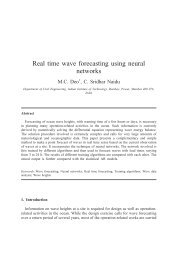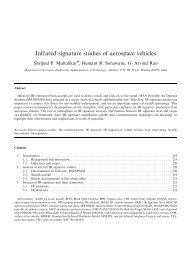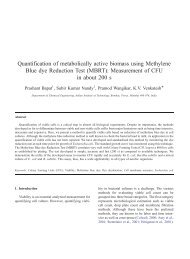A Measurement Study of the Linux TCP/IP Stack Performance and ...
A Measurement Study of the Linux TCP/IP Stack Performance and ...
A Measurement Study of the Linux TCP/IP Stack Performance and ...
Create successful ePaper yourself
Turn your PDF publications into a flip-book with our unique Google optimized e-Paper software.
were blocking calls - an accurate resource usage <strong>of</strong><br />
this could not be obtained from strace.<br />
A separate experiment was done to pr<strong>of</strong>ile <strong>the</strong><br />
accept <strong>and</strong> close system calls. In this experiment,<br />
<strong>the</strong> clients were on a separate machine, with <strong>the</strong><br />
servers on <strong>the</strong> Pentium IV server. Instead <strong>of</strong> using<br />
strace on <strong>the</strong> server, <strong>the</strong> CPU time consumed in<br />
server system calls (accept <strong>and</strong> close) was estimated<br />
by <strong>the</strong> "utilization law" [8] (i.e. utilization was<br />
divided by throughput, to give CPU time). The results,<br />
shown in Table II, indicate that <strong>the</strong> processing<br />
time in kernel 2.6 for connection setup <strong>and</strong> tear<br />
down is higher than that <strong>of</strong> kernel 2.4. This can<br />
be attributed to <strong>the</strong> many security hooks that kernel<br />
2.6 socket code contains. For example, <strong>the</strong> socket<br />
system call in kernel 2.6 additionally invokes <strong>the</strong><br />
functions security_socket_create() <strong>and</strong><br />
security_socket_post_create().<br />
CPU Time/conn. (ss)l<br />
Kernel 2.4 95.02<br />
Kernel 2.6 105.30<br />
TABLEII<br />
TIME SPENT IN accept AND close CALLS.<br />
B. Connection throughput<br />
The socket system call pr<strong>of</strong>iles did not reveal<br />
significant differences in performance between <strong>the</strong><br />
two kernels. However, <strong>the</strong>se measurements were<br />
done at a low to medium load on <strong>the</strong> system (unto<br />
60% utilization). We are, however, also interested in<br />
<strong>the</strong> maximum achievable capacity <strong>of</strong> <strong>the</strong> two kernels<br />
- specifically, to confirm whe<strong>the</strong>r throughput continues<br />
to increase proportionally with <strong>the</strong> <strong>of</strong>fered load<br />
coming to <strong>the</strong> system. Using <strong>the</strong> numbers shown<br />
in Table 11, we can estimate maximum connection<br />
rate achievable by Kernel 2.4 to be 1 - 10500<br />
95.02ps<br />
connections per second <strong>and</strong> that for Kernel 2.6 to<br />
be 1O5.3/s 9500 connections per second.<br />
Figure 1 shows <strong>the</strong> throughput vs number <strong>of</strong><br />
active connections for an experiment in which multiple<br />
clients repeatedly connected <strong>and</strong> disconnected<br />
from <strong>the</strong> server without transmitting any data. The<br />
peak throughput agrees with <strong>the</strong> projected capacity<br />
quite well, for both <strong>the</strong> kernels; thus in this experiment,<br />
where maximum number <strong>of</strong> open connections<br />
were 100, <strong>the</strong>re were no unexpected bottlenecks.<br />
To stress <strong>the</strong> system fur<strong>the</strong>r, we carried out <strong>the</strong><br />
following experiment: <strong>the</strong> server had 300 threads<br />
with open ports out <strong>of</strong> which at any time a subset <strong>of</strong><br />
N ports were made active (i.e. with which clients<br />
opened <strong>and</strong> closed connections). Results obtained<br />
from <strong>the</strong> experiments, where N was varied from<br />
10 to 100 are also shown in Figure 2.<br />
Figure 2 shows a completely different throughput<br />
curve for kernel 2.4, <strong>and</strong> only a slightly different<br />
curve for kernel 2.6. While kernel 2.6 throughput<br />
continued to show a proportional increase in<br />
throughput with increasing load, kernel 2.4 reveals a<br />
significant slowdown (e.g. when clients double from<br />
20 to 40, throughput increases from 4000 to only<br />
about 5200 - far from double). Kernel 2.6 maximum<br />
capacity came down to about 8500 (achieved with<br />
30 connections), while kernel 2.4 capacity was<br />
about 9000 - achieved at 100 active connections.<br />
We believe this is due to <strong>the</strong> superiority <strong>of</strong> <strong>the</strong><br />
kernel 2.6 scheduler. The kernel 2.4 scheduler has to<br />
cycle through all <strong>the</strong> processes listening on <strong>the</strong> open<br />
ports in <strong>the</strong> system irrespective <strong>of</strong> <strong>the</strong> fact that <strong>the</strong>y<br />
are active or not. On <strong>the</strong> o<strong>the</strong>r h<strong>and</strong> <strong>the</strong> kernel 2.6<br />
scheduler is relatively less affected by <strong>the</strong> number<br />
<strong>of</strong> open ports in <strong>the</strong> system <strong>and</strong> its performance<br />
remains comparable to <strong>the</strong> earlier case.<br />
o<br />
10000<br />
,, 8000_/<br />
o 6000<br />
F_ 4000 F<br />
Connection Thruput comparision<br />
2000 0 20 40 60 80<br />
Number <strong>of</strong> Client Processes<br />
Kernel 2.6<br />
Kernel 2.4<br />
100 120<br />
Fig. 1. Connection throughput comparison with varying number<br />
<strong>of</strong> client connection threads.<br />
Authorized licensed use limited to: INDIAN INSTITUTE OF TECHNOLOGY BOMBAY. Downloaded on April 29, 2009 at 00:47 from IEEE Xplore. Restrictions apply.<br />
4


